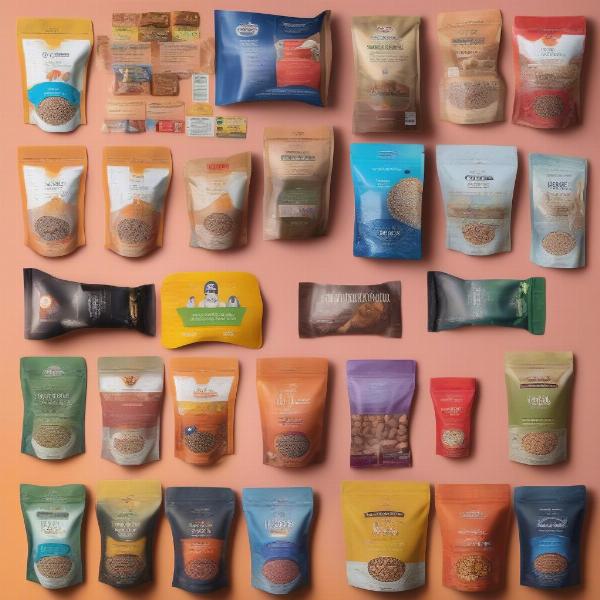Dog food in a pouch offers a convenient alternative to traditional canned or dry kibble, especially for pet owners on the go. But are these pouches packed with the same nutritional value as other dog food formats? This article dives deep into the world of dog food pouches, exploring their benefits, drawbacks, and everything you need to know to make the best choice for your furry friend.
Understanding the Appeal of Pouched Dog Food
Pouches offer several advantages that make them an attractive option for many dog owners. Portion control is a significant benefit, with each pouch containing a single serving, minimizing waste and ensuring freshness. This is particularly useful for small dogs or those with specific dietary needs. The easy-open packaging and squeezable format make serving a breeze, whether you’re at home or traveling. Moreover, many pouches offer a variety of flavors and textures, catering to even the pickiest of eaters. But convenience isn’t the only consideration. Nutritional value is paramount. Let’s examine how dog food in a pouch stacks up against other options.
Nutritional Value of Dog Food in a Pouch
Just like other dog food types, the nutritional content of pouches varies widely depending on the brand and recipe. High-quality pouches can provide a complete and balanced diet, containing essential vitamins, minerals, proteins, and fats necessary for your dog’s health. Look for pouches that meet AAFCO (Association of American Feed Control Officials) standards, which indicate that the food meets the minimum nutritional requirements for dogs.  Comparing different brands of dog food pouches wet dog food pouches often feature a higher moisture content than dry kibble, which can be beneficial for dogs prone to dehydration or urinary tract issues.
Comparing different brands of dog food pouches wet dog food pouches often feature a higher moisture content than dry kibble, which can be beneficial for dogs prone to dehydration or urinary tract issues.
Choosing the Right Pouch for Your Dog
With so many options available, selecting the right pouch can be overwhelming. Consider your dog’s age, breed, activity level, and any specific dietary needs or allergies when making your choice. Puppies, adult dogs, and senior dogs have different nutritional requirements. For example, puppies need higher levels of protein and calories for growth, while senior dogs may benefit from lower-fat options. dog food pouches come in a variety of formulations, including grain-free, limited ingredient, and those specifically designed for sensitive stomachs.
Incorporating Pouches into Your Dog’s Diet
Pouches can be used as a complete meal, a supplement to dry kibble, or as a tasty treat. Some owners choose to mix pouches with dry food to add flavor and moisture, while others use them as a standalone meal replacement. dog food pouches in gravy can be especially appealing to dogs who prefer moist food. Regardless of how you incorporate pouches, always ensure your dog has access to fresh, clean water.
Are There Any Downsides to Pouches?
While convenient, pouches can be more expensive than other dog food options. They also generate more packaging waste, which is an important environmental consideration. can wet dog food can be a more sustainable alternative, although less convenient for single servings. Some dogs may also find the texture of certain pouches less appealing than traditional wet or dry food.
Conclusion: Weighing the Pros and Cons of Dog Food in a Pouch
Dog food in a pouch offers a convenient and often nutritious option for busy pet owners. While cost and environmental impact are factors to consider, the benefits of portion control, ease of use, and variety can make pouches a worthwhile choice for many dogs. By carefully considering your dog’s individual needs and selecting high-quality products, you can ensure your furry friend receives a balanced and enjoyable diet.
FAQ
- Are all dog food pouches nutritionally complete? No, not all pouches are created equal. Look for pouches that meet AAFCO standards to ensure they provide a balanced diet.
- Can I mix pouches with dry food? Yes, many owners mix pouches with dry kibble to add flavor and moisture.
- Are pouches suitable for puppies? Yes, there are pouches specifically formulated for puppies’ nutritional needs.
- Are pouches more expensive than canned food? Generally, pouches tend to be more expensive per serving than canned food.
- What should I do with leftover food from a pouch? Refrigerate any uneaten portion and discard after 24 hours.
- Are there grain-free pouch options available? Yes, many brands offer grain-free pouch options for dogs with sensitivities.
- Can I use pouches as a treat? Yes, pouches can be used as a high-value treat or as a meal topper.
ILM Dog: Your Trusted Partner in Pet Care
ILM Dog is a leading international online resource dedicated to providing expert advice and information on all aspects of dog care, from breed selection and nutrition to training and health. We offer practical, reliable guidance to help you navigate every stage of your dog’s life. Whether you’re a new dog owner or a seasoned expert, ILM Dog is here to support you. Contact us today for personalized advice on your dog’s nutritional needs and discover a world of resources to enhance your pet’s well-being. Email: [email protected], Phone: +44 20-3965-8624. dog food with gravy can be a great option for picky eaters.